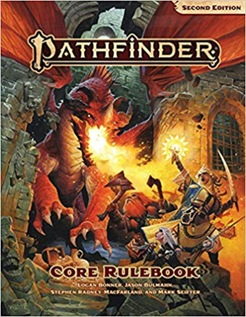As part of my investigation of Pathfinder 2nd edition, I ran The Absalom Initiation, an introductory Pathfinder Society adventure, on the weekend. I had a group of five players, with varying levels of familiarity with the PF2 rules, and we played three of the four missions in the adventure. Like the introductory D&D Adventurers League adventures that I’m more familiar with, this adventure has the leaders of the four PFS factions each give the characters a mission. The adventure is intended to be replayable, and there are several different missions (four locations, each is the site of three separate missions, only one of each is used at each location on a given play-through).
The mission briefing encounter would probably make more sense if I’d read the Pathfinder Society Guide before I ran it, so I knew what the factions were, but I could work out most of the details from the text. (For some reason, reading a 50+ page document in preparation for non-PFS play wasn’t that appealing). The finer details of the factions were mostly irrelevant, as we played it as “Here’s the missions, go on them. Get rewards!” The briefing has the potential for appealing role-playing, if your players are interested in that.
The first mission was to restore a petrified naga to life. Finding the naga? That was easy. Getting to the naga? Not so easy. In the way was a crowd of people who didn’t want her restored. This encounter was the weakest of the three; it felt like it builded down to roll-playing. The adventure strives to be replayable by changing up what’s going on each time (you make random rolls to determine the specifics of the quests), but it left the motivations of the crowd very unclear. For this game, a group of charlatans didn’t want her restored, and you could make Thievery checks to persuade them otherwise. Why Thievery? How does that even tie in? I didn’t have a clue. In any case, the players quickly flubbed the role-playing, rolled very badly on their Thievery checks, and the crowd attacked. A round later, the crowd ran away because I rolled poorly for initiative and the players didn’t.
There’s a good idea here, but it needed more development and attention to detail. To turn this from roll-playing into role-playing, I need good hooks for the interaction.
The second mission was to deal with an escaped beast on a sunken ship. This one was more interesting, with a bit of exploration and then a combat (the players chose not to try to charm the beast). We didn’t use a battlegrid, and so the characters surrounded the beast and the battle ended up just as a melee. Despite that, it was a good one. The beast had enough stats to prove troublesome for the players, with one character knocked unconscious and others badly hurt before it was dealt with. The exploration elements were fairly minor; they’d probably be more interesting in another version of the scenario.
One thing that came up: One player grabbed the beast (so it couldn’t move) and wanted to drag it. This is defined nicely and easily in the 5E rules. It’s not mentioned at all in the PF2 rules – something of a surprise. (The rules note that if you move, the creature is no longer grabbed).
The alchemist of the group ignored her bombs and moved into melee, which was fairly underwhelming. I don’t know what the alchemist is like – are they poor against lone opponents, or do they have options the player didn’t know about?
Sadly, there wasn’t a wizard in the group.
The third mission was to explore a haunted house and discover why it was haunted. This was full-on exploration, with no combat (just a couple of hazards/traps to deal with). I enjoyed it, but I think that had a lot to do with the way the players encountered things. It’s very easy for the players to encounter the interesting rooms first, then end with a damp squib of boring room after boring room. I think it wants to use the 10-minute turns of exploration more than we did, but there’s not a great deal going on. There are basically only three significant encounter areas, and there’s not much agency on the part of the players. Either they roll well, or they don’t; not much chance for good play.
The encounters are evocative, however, and that’s what I wanted.
I and the players would have preferred an adventure that was a solid block rather than several missions, but I didn’t realise that until too late. I found the format of the adventure to be somewhat confusing, with some details in the appendix that seemed they should be in main encounter text. Mostly it ran fine, however.
I was not that impressed that the NPC art during the faction briefings was always on the NEXT page – amongst the details of the following briefing.
Overall, it was fine. There are a lot of subtleties in the PF2 rules I’m still not sure about, and I’m not sure when I’ll next get a chance to play. There’s potential in the adventure, but for so many words and pages, it occasionally felt that more detail was needed in the right areas.

